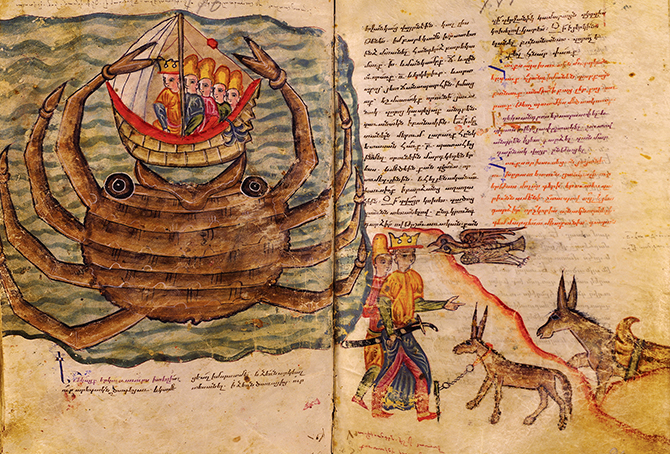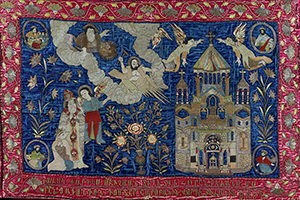MUSEUM HAPPENINGS
Christmas At The Met

By Clint Brownfield
The Metropolitan Museum of Art, with its three locations--the main building on Fifth Avenue, the Met Breuer on Madison Avenue (formerly the location of the Whitney Museum of American Art) and the Met Cloisters, way uptown in Manhattan’s Fort Tryon Park—has many distinctions. But what is not up for dispute is the fact that The Met is New York City’s most visited attraction. That includes such staples as the Empire State Building, the Statue of Liberty and Ellis Island.
The holidays are a particularly festive time to visit The Met. This year visitors can view an incredible array of exhibits running through the beginning of the New Year, with shows devoted to, among others, the works of the Dutch Masters, Delacroix, Tintoretto, and a truly spectacular display of jewelry from The Met’s permanent collection.

ART & ARTIFACTS
A standout in this very impressive group of shows is one in particular—Armenia! which runs through January 13, 2019. This exhibition not only includes a spectacular array of art and artifacts from Armenia but also offers a great example of how the Met’s resources and connections can be used to create amazing and comprehensive shows of art and objects from all over the world. Not many other museums around the world can do this.
Armenia! explores the arts and culture of the Armenians from their conversion to Christianity in the early fourth century through their leading role on international trade routes in the 17th century. The exhibition emphasizes how Armenians developed a distinctive national identity in their homeland at the base of Mt. Ararat (widely accepted as the resting place of Noah’s Ark) and how they maintained and transformed their traditions as their communities expanded across the globe.

A SPECIAL CHRISTMAS DISPLAY
New York City has a number of very famous Christmas trees, and the Metropolitan Museum of Art has one so unique that many New Yorkers and visitors from all over the world come to The Met during the holidays to marvel at the 20-foot blue spruce located in the Fifth Avenue building’s Medieval Sculpture Hall.
The tree and the 18th-century baroque Neapolitan crèche at its base have evolved down through the years to arrive at its present-day priceless splendor. This year, it will be on view through the 12th night, January 6th, with recorded Christmas music to add to the enjoyment of the holiday display.
The tree is gracefully lit and adorned with 19 cherubs and 59 angels, while at the base an additional 71 figures represent the three elements of Nativity scenes that were traditional to 18th-century Naples: adoring shepherds and their flocks, the procession of the three Magi, and spirited peasants and townspeople. The display is enhanced by nearly 50 delightful animals and by background pieces that create a dramatic setting for the Nativity, including the ruins of a Roman temple, several quaint houses, and a typical Italian fountain. Materials used to create these decorations include poly-chromed terracotta, wood, wire wrapped in tow and various fabrics.
THE HISTORY
The annual Christmas display has evolved through the generosity, enthusiasm, and dedication of the late Loretta Hines Howard, who began collecting crèche figures in 1925. Mrs. Howard conceived the idea of presenting the elaborate Neapolitan Nativity scene under a Christmas tree—a tradition rooted in Northern Europe, with angels swirling upward to the crowning star—and was later ably assisted by her daughter Linn Howard who contributed to the tree’s great beauty by adding and improving details that are reflected in the current display.
This unusual combination was first presented to the public in 1957, with The Met’s exhibition of Mrs. Howard’s collection. Since 1964, Loretta Hines Howard has given more than 200 Neapolitan crèche figures from the 18th century to The Met. --CB

MAGNIFICENT TREASURES
“This is the first major exhibition to celebrate the remarkable artistic achievements of Armenians in the Middle Ages, and the exceptional works of art on view will be a revelation to many of our visitors,” said Max Hollein, Director of The Met. “By examining these magnificent treasures, we can better understand and appreciate the central role that art played in defining and connecting Armenian communities during this time, and how they both influenced and were inspired by styles from other cultures.”
More than 140 opulent gilded reliquaries, richly illuminated manuscripts, rare textiles, liturgical furnishings made of precious materials, khachkars (cross-stones), church models, and printed books demonstrate Armenia’s distinctive imagery in their homeland and other major Armenian sites, from the Kingdom of Cilicia on the Mediterranean to New Julfa, in Safavid Persia.
Armenia! focuses on major Armenian centers of production from their homeland west and east. It includes images of Armenians, from self-portraits to depictions of male and female rulers, donors, theologians, and historians.
More than half of the works on display are on loan from The Republic of Armenia with the support of The Ministry of Culture. Imposing liturgical works are from the Mother See of Holy Etchmiadzin, the primary site of the Armenian Church. In Yerevan, Armenia’s capital, the “Matenadaran” Mesrop Masthots` Institute—Museum of Ancient Manuscripts—has lent rare manuscripts, and the History Museum of Armenia has lent monumental church sculptures. Additional works are from The Met’s permanent collection and other American and European institutions.
For more information on The Metropolitan Museum of Art, visit metmuseum.org.














